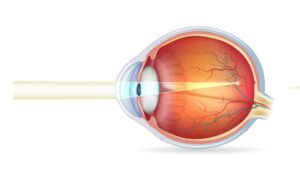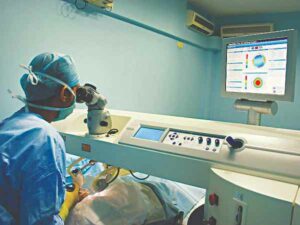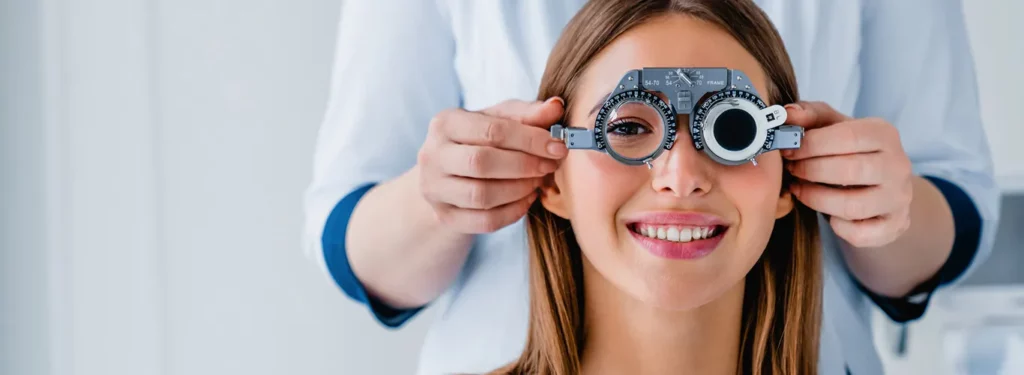Do you suffer from myopia or nearsightedness? If so, you’re not alone—nearly 30% of the world’s population is myopic. And while glasses and contact lenses are a common solution to improve vision, they’re not the only option. Myopia correction surgery is a popular and effective treatment for those with myopia. But as with any surgery, it’s important to understand the risks and benefits before making a decision. In this blog post, we will explore everything you should know about this surgery. From the different types of surgery available to the risks and benefits, read on to learn more about this topic.
Contents
What Is Myopia?

Myopia, also known as nearsightedness, is a refractive error in the eye where light focuses in front of the retina instead of on it. This causes distant objects to appear blurry while close objects appear clear. Myopia occurs when the eyeball is too long or when the cornea has too much curvature. It typically develops during childhood and worsens with age.
There are several types of myopia correction surgery, including LASIK, PRK, and Visian ICL. LASIK is the most common type of myopia surgery and involves using a laser to create a flap in the cornea. The laser then reshapes the cornea to correct the refractive error. PRK is similar to LASIK but does not involve creating a flap in the cornea. Instead, the surface layer of the cornea is removed and the laser is used to reshape the underlying tissue. Visian ICL involves implanting a small lens inside the eye to correct the refractive error.
Myopia correction surgery is safe and effective at correcting vision problems caused by myopia. The risks associated with myopia surgery are low, but they include dry eyes, infection, and vision fluctuations. Most people who have myopia surgery experience significant improvements in their vision and do not experience any serious complications.
What Is Myopia Correction Surgery?
If you have myopia or nearsightedness, you may be considering myopia correction surgery. Myopia correction surgery is a type of refractive surgery that can correct your vision and reduce your dependence on glasses or contact lenses.
There are several types of this correction surgery, but the most common is LASIK. LASIK is a laser-based surgery that involves reshaping the cornea, the clear front surface of the eye. By correcting the shape of the cornea, light can be properly focused onto the retina, resulting in clearer vision.
LASIK is a very safe and effective procedure, and most people experience significant improvement in their vision after surgery. In fact, many people achieve 20/20 vision or better after LASIK.
If you are considering myopia correction surgery, be sure to talk to your eye doctor to learn more about the different types of procedures and what would be best for you.
How Does Myopia Correction Surgery Work?
 Myopia correction surgery is performed by a specialist ophthalmologist in order to improve the focusing power of the eye. There are two main types of myopia correction surgery: laser-based surgery and refractive surgery.
Myopia correction surgery is performed by a specialist ophthalmologist in order to improve the focusing power of the eye. There are two main types of myopia correction surgery: laser-based surgery and refractive surgery.
Laser-based myopia correction surgery uses a laser to reshape the cornea, which is the clear, front surface of the eye. The surgeon will first create a small flap in the cornea with a blade or laser. They will then use the laser to remove some tissue from the cornea. This will cause the cornea to flatten out and allow light to be focused directly on the retina, rather than in front or behind it.
Refractive surgery involves making small incisions in the eye in order to change its shape. This can be done either by removing tissue from the eye or by adding an implant into the eye. Both of these methods will ultimately change how light is bent when it enters the eye, and as a result, improve vision.
Myopia correction surgery is generally safe and effective, though there are some risks involved as with any type of surgery. These risks will be discussed with you prior to your procedure so that you can make an informed decision about whether or not to proceed with surgery.
Who Is A Candidate For Myopia Correction Surgery?

If you are nearsighted, or myopic, you may be a candidate for this correction surgery. Myopia is a refractive error, which means that the eye does not focus on light properly. This results in blurry distance vision. Myopia can be mild, moderate, or severe. If you have myopia, you may be able to see clearly up close but not far away. Or, you may only be able to see clearly when wearing corrective lenses such as glasses or contact lenses.
Myopia correction surgery is a type of refractive surgery. The goal of this surgery is to reduce or eliminate your dependence on corrective lenses. There are several types of this correction surgery: photorefractive keratectomy (PRK), laser-assisted in situ keratomileusis (LASIK), and implantable collamer lens (ICL).
PRK is the oldest type of this correction surgery. It involves reshaping the cornea with an excimer laser. LASIK is the most common type of myopia correction surgery. It also involves reshaping the cornea with an excimer laser but uses a different technique than PRK. ICL is a newer type of myopia correction surgery that involves implanting a lens inside your eye.
Your doctor will determine if you are a candidate for myopia correction surgery based on several factors: age, the severity of myopia, overall health, and stability of vision.
What Are The Risks And Side Effects Of Myopia Correction Surgery?
There are several risks and side effects associated with this correction surgery, which include:
1. Infection: There is a risk of infection following any type of surgery. This risk can be increased if the eye is not kept clean and free of debris following the procedure.
2. Bleeding: Bleeding can occur during or after the surgery. This is usually minor and will resolve on its own, but in some cases, it may require additional treatment.
3. Swelling: Swelling is common after any type of surgery and can last for several days or weeks. It is important to keep the head elevated and to use ice packs as directed to help reduce swelling.
4. Pain: Some degree of pain is to be expected following this correction surgery. pain medication can be taken as needed to help control discomfort.
5. Vision problems: There is a risk that vision may be worsened or not improved at all following myopia correction surgery. In some cases, glasses or contact lenses may still be required for the best vision.
How Much Does Myopia Correction Surgery Cost?
Myopia correction surgery is a very expensive procedure. The cost of the surgery can range from INR 35,000 to INR 1,35,000. The cost of the surgery will vary depending on the type of surgery that you have, the severity of your myopia, and the location of the surgery.
Conclusion
In conclusion, myopia correction surgery is a popular and effective treatment for those with myopia. It is generally safe and effective, with most people experiencing significant improvements in their vision after surgery. However, there are risks associated with the surgery, including infection, bleeding, swelling, pain, and vision problems. This surgery is also very expensive; the cost of the surgery can range from INR 35,000 to INR 1,35,000 depending on the type of procedure you have and where it is performed. Talk to your doctor if you are considering this procedure to learn more about the risks and benefits of this surgery.
Generally, Lasik surgery is a safe 10-minute procedure to help you get rid of glasses. For other information and guidance, please connect with MantraCare. This platform offers the most advanced Lasik options. If you have any questions on lasik surgery feel free to reach out to us at +91-9711116605.
